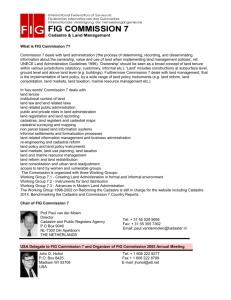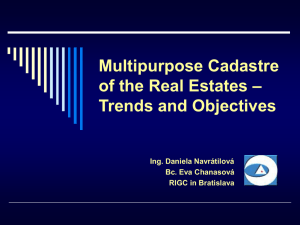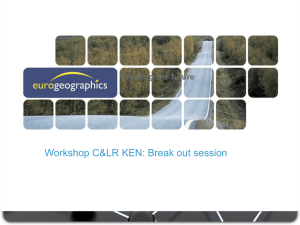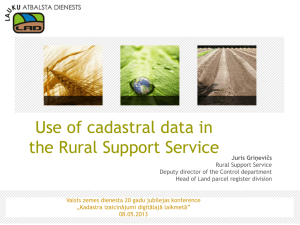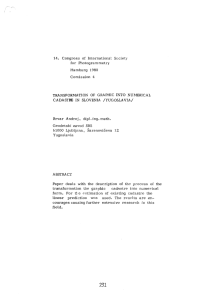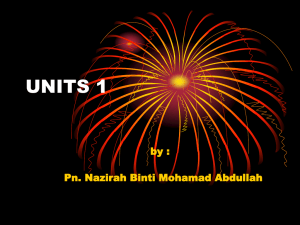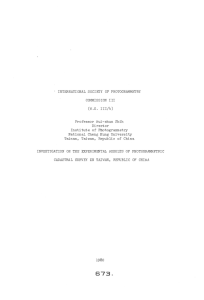Presented for commission No IV group and 3
advertisement
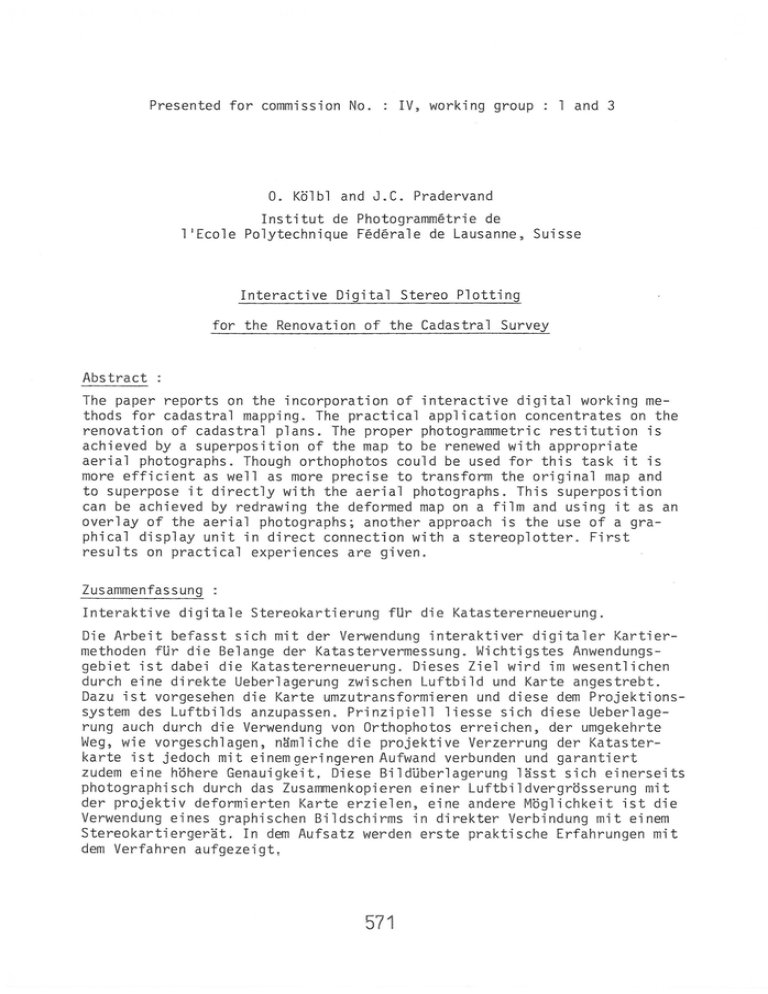
Presented for commission No . IV , working group 1 and 3 0. Kolbl and J . C. Pradervand Institut de Photogrammetrie de 1 1 Ecole Polytechnique Federale de Lausanne, Suisse Interactive Digital Stereo Plotting for the Renovation of the Cadastral Survey Abstract : The paper reports on the incorporation of interactive digital working me thods for cadastral mapping. The practica l application concentrates on the renovation of cadastral plans . The proper photogrammetric restitution is achieved by a superposition of the map to be renewed with appropriate aer i al photographs . Though orthophotos could be used for this task it is more efficient as well as more precise to transform the original map and to superpose it directly with the aerial photographs . This superposition can be achieved by redrawing the deformed map on a film and using it as an overlay of the aer ial photographs ; another approach is the use of a gra phical display unit in direct connection with a stereopl otter . First results on practical experiences are given . Zusammenfassung : Interaktive digitale Stereokartierung fUr die Katastererneuerung. Di e Arbeit befasst sich mit der Verwendung interaktiver dig i taler Kartiermethoden fUr die Belange der Katastervermessung. Wichtigstes Anwendungs gebiet ist dabe i die Katastererneuerung. Dieses Ziel wird im wesentlichen durch eine direkte Ueberlagerung zwischen Luftbild und Karte angestrebt . Dazu ist vorgesehen die Karte umzutransformieren und diese dem Projektions system des Luftbilds anzupassen . Prinzipiell liesse sich diese Ueberlage rung auch durch die Verwendung von Orthophotos erreichen, der umgekehrte Weg, wie vorgeschlagen, ntlmliche die projektive Verzerrung der Katasterkarte i st jedoch mit einemgeringeren Aufwand verbunden und garantiert zudem eine hohere Genauigkeit , Diese BildUberlagerung lasst s i ch einerseits photograph is ch durch das Zusammenkop i eren einer Luftbildvergrosserung mit der projektiv deformierten Karte erz ie len , eine andere Moglichkeit ist die Verwendung e i nes graphischen Bildsch irms in direkter Verbindung mit einem Stereokartiergerat . In dem Aufsatz werden erste praktische Erfahrungen mit dem Verfahren aufgezeigt , 571 Sommaire : Restitution digitale interactive pour la renovation du cadastre . L'article traite l'utilisation des processus digitaux interactifs pour les besoins de la mensurat i on cadastrale. Les applications pratiques sont con centrees sur la renovation du cadastre . Ce but est essentie ll ement atteint par une superposition directe des photographies aeriennes et des plans cadastraux . A cette fin , on transforme les plans cadastraux et on les adapte au systeme de projection des photograph i es aeriennes . Cette adaptation pourrait aussi ~tre faite par 1 'intermediaire d'orthophotos; cepen dant ~ la methode inverse proposee, c ' est ~ a - dire la deformation projecti ve des plans cadastraux, s ' est averee plus efficace et garanti t une meil l eure precision. Cette superposition peut s'effectuer par des moyens photogra phiques d'une part et , d ' autre part , par un ecran graphique directement lie a un stereorestituteur . De prem i eres experiences du procede sont demon trees dans cette etude . 1. Introduction Several countries, including Switzerland, are heavily preoccupied with the creation of a land in formation system . The cadastral survey represents one of the most important information bases for such a system . The i mplementa tion of a numerical cadastre on a computer presents no major difficulties . However, several European countries di spose of a graphical cadastre, of which parts may date back to the beginning of the last century . The transformation of these graphical documents into a numerical form presents considerable difficulties . In the i r original form the precis i on of these plans was surprisingly high . The intermediate rev i s i ons and changes have caused serious degradation of the origina l precision . Th i s i s not astonish ing since these plans were not real l y intended to be revised . This explains why most of these documents dispose of neither a co - ordinate grid nor a suffic i ent number of control points. Consequently, the simp l e digit i zi ng of these documents could give rise to severe degradation of the existing information. However a completely new cadastral survey wou ld cause considerable extra cost . It i s therefore of great i mportance to find al ternatives and one possibility is the inclusion of photogrammetrica l means into the process . Photogrammetric methods for cadastral surveys ar e very well known . The dis advantages of photogrammetry are the great number of details which cannot be seen from the air and the need to signalize a certa in number of points . These deficiencies are l argely eliminated when the photographic image is on l y used as a reference for overall contro l and for the select i on of appropr i ate check poin ts for the transformation of the graphical map i nto the 572 nationa l co - ord in ate system , In th i s way the tedious completion work on the ground, typical of a photogrammetric survey , is avo i ded and the opera tion is limited to the geometrica l comparison of the photograph i c image with the cadastra l map . However, such a comparison requires the geometric adaptati on of the two information carriers , This adaptati on could be achieved by ster eop l otting or by the production of orthophotos, but practical experience shows that it is more efficient to transpose the contents of the prev i ous l y digitized map i nto the project i on system of the aerial photographs . Th i s operation allows direct superposition of the line map and the photograph, which con siderably facilitates the detecti on of geometrica l discrepanc i es . This document may even be ta ken in to the field and ver ifi ed on the spot . Thi s first transformation i s followed by a second phase of adaptations which may be considered as the proper renovation of the cadastre . Finally , for control, the corrected cadastral map can again be transposed into the projection system of the photograph . Practical experience has shown that a map which has been revised several times might have a very heterogeneous geometry and a simple transforma tion, even by sp line functions or l east squares interpolation, does not really meet the effective requirements . Much better results may be ob tained by a zonal transformation , taking into account the particularities of map revision. Although such a procedure takes a considerable time, the costs are far lower than for a new survey and the resu l ting precision shou l d be adequate for the requirements of a modern cadastre . The practical experiences concentrated up to now on a municipality in the North of Lausanne (Municipa lity of Echa ll ens) and on a co untry estate in the northern Jura . Before entering into the proper investigation , the historical development of the cadastral survey is shown up on the special example of the canton of Vaud , In the 3rd chapter the instrumentation used for the exper i ences are presented and in the follow in g chapters the preparation of the necessary map materia l and the proper r enovation of the cadastra l survey are discussed, 2, Hi stori cal development Digitizing graphical map documents and their renovation i s of special in terest in regions where a high quality survey i s ava il ab l e which is continuous ly revised and which corresponds to the actua l state . The problem is of spec i al importance for the western cantons of Switzerl and . Great parts of the original cadastra l survey stil l in use date back to the beginning of the l ast century , The documents are permanentl y revised and the map contents coincide with the actua l prescriptions . The cadastral survey of the canton of Vaud , for example , was ini tiated by l aw in 1804 and ordered a survey of the whole province , The measurements were comp l eted around 1850 , The ma in objecti ve of this survey was to find an equitable base for taxation , Very soon the legal aspect became predomi nant, Already in 1840 an in dex of rights and obligations was i nstal l ed and at the end of the century the registration of al l servitudes became compulsory , In this way the canton already disposed of a highly developed cadastre of the whole territory when in 1912 a survey of the whole of Switzerland was ordered by the centra l government . 573 The initial cadastral survey of the canton of Vaud was effected purely graphically, with the help of the plane table . The sheets are comp l etely independent, limited by natural boundaries and without reference to the national grid system (cf. Fig . 3) . In spite of the simplicity of the method relatively high inner precision was obtained . At the beginning of this century the purely graphical method was replaced by a semi - numerical procedure, wh i ch means that the field survey is performed numerically whereas the base for the legal cadastre remained a graphical document , Around 1960 the progress in electronic data handling initiated the creation of a purely numerical cadastre and the progressive transformation of the actual survey into a numerical information system . 3. Photogrammetric equipment and computer facilities The proposed method for cadastral renovation is mainly based on the direct comparison of a map with its corresponding aerial photograph . However, such a comparison requires an appropriate combination of the previously digitized map co-ordinates with the measurements effected in the stereomodel. In order to facilitate these data manipulati ons it seemed necessa ry to make use of a graphical work station in conjunction with a stereo plotter . The instrumentation used for this work is a Wi l d A 10 stereoplotter equipped with an automatic registration device, a table computer with a graphi cal display unit (Hewlett- Packard 9845 T) and an automatic drawing table connected to amini-computer (Coradi Coradomat MK3 with a General Automa tion SPC-16 computer) . Figure 1 shows the layout of the different instru ments and the possibilities for data transfer. The stereoplotter and the computer are connected via an automatic registration device (Wild EK22) by a l6 ~ bit parallel interface . The reg i stra tion device was programmed to offer data to the computer every 0 .02 sec . However the computer on l y reads these data when it executes the correspon ding read instructions in its internal program . Besides the spatial model co-ordinates, a point identifier is also read which characterizes the data . Further, the operator disposes of a foot switch, which was programmed to initiate the plotting of line or point symbols and the storage of a co ordinate in a data file . A preliminary transformation is necessary if the registered values are to be compared with , or superimposed on , other data registered on another device (e .g . digitized cadastral map) . The computer facilities described up to now more or less correspond to the possibilities of a conventional drawing table of a stereoplotter. Additional features of the system are a graphical editi ng routine and the possi bi lity of controlling the plott i ng process by the computer . The latter faci l ity is of special importance for file manipulat i ons in cadastral reno vation , In this mode a special symbo l on the graphic disp l ay guides the operator through the sequence of po i nts to be measured . The necessary prec1s1on is achieved by zooming, which allows a po i nting accuracy of up to 1 micron (screen size 540 x 480 points) to be obtained . The comouter facil i ties around the stereoplotter are complemented by high performance automatic drawing tab l e, used for prec i sion drawing of the cadastral maps . This table is steered by a min i- computer equ i pped with a 574 Fig . 1 "J iew of the instruments used for cadastral renovation by photogrammetry. The essential parts are the stereoplotter in on-line connection to a ~ omputer with graphical display un i t and the automatic irawing table controlled by a ~ini-comput er . The mini-comput er is in dialo g with the r~ raphical system, whereas the f eed back to the stereoplotter i s assured only visually by t he operator. I Fig. 2 \ "-, I : 1\, i \y Transfer of a grid (map) into the projection system of aerial photographs. For such a transfer the orientation elements of the photographs, the planimetric co-ordinates as well as the height of each point have to be taken i nto account . ,/ i\ ./ ·. J \\ \ ~- - \ ~=~==::::11~--' - . \ 575 Fi g . :_; Section of a map used for renovation ; scale 1 : 1000 , area Echallens , Vaud , original survey about 1840 but still valid . Very typical is the initial great number of parcels regrouped later on . Obsolete lines are not erased but only marked by two dashes . In order to avoid confusion it was necessary to emphasis the actual situation by colour pencil (grey in the reproduction) . magnetic tape unit and two di s k un i ts of 5 Mbyte . An on-l ine co nnection of the table computer to the mini i s necessary fo r data tra nsfer and would al low t he di sk un i ts to be in corporated i nto the i nt eractive data management dur i ng the pl ot t i ng process . 576 Fig. 4 Superimposition of an aerial photograph with a cadastral map (same section as Figure 3). The transfer was done analytically correct and deviations are purely due to errors of the map (e.g. the park limit should coincide with the border line) . The buildings are plotted two times, the dashed line corresponds to their base at the level of the roof. The plot is very heavy in order to facilitate the reproduction (Photograph reproduced by courtesy of the Federal Directorate for Cadastral Survey, Bern). 4. Preparation of the working material Obviously a thorough renovation of a cadastral map cannot. be made without field verification . It is therefore important to design , apart from the photogrammetric restitution, the appropriate tools which may serve as the basis for this field work . It has already been pointed out, in the introduction, that enlargements of the aerial photographs with the superimposed 577 cadastral map are most useful for these activities . This phase also includes the preparation and the taking of the aerial photographs . It proved most useful to foresee the signalization of the control points intended for the orientation of the photographs in the stereoplotter, as well as of a certain number of boundary marks in open rural areas . The photographs for the practical experiments were taken in May 1978, before the appearance of the young leaves; this flight was performed without any signalization. A second flight is planned for this spring, for which considerable efforts for signalization have been made. A scale of 1:4500 was chosen for the aerial photographs. The preparation phase also included the digitizing of the original map documents on a special digitizer . The data file, with the di gitized coordinates, was transferred to the table computer linked to the stereo plotter and served as the reference for the determination of the heights of all cadastral points by photogrammetric measurements. At the same time the orientation elements of the photographs were determined with the help of grid measurements. This information is needed for the subsequent trans formation of the cadastral points into the projection system of the photo graphs (cf. Fig. 2). Finally the projective deformed map was plotted on the automatic drawing table and superimposed on an enlarged photograph in a rectifier (cf . Fig. 4). The precision required for the height measurements is in the order of 10 em, because of the planimetric precision required of a cadastral map . This explains why the inverse procedure, namely the preparation of an orthophoto and its superimposition on the original cadastral map would never yield similarly high precision. In general a map sheet of 50 x 70 em (scale 1:1000) included 1000 to 1500 points. Consequently it was sufficient to measure the heights of this number of points, whereas an orthophoto would have required a much larger number of height points because it would have been necessary to measure the heights, with the required precision, all over the image . Furthermore it proved extremely useful to calculate two height levels for the buildings, namely the ground and the roof levels . In this way it was possible to draw the projective deformed perimeter of the buildings given by the map at both levels (cf . Fig . 4). The equivalent procedure for orthophotos would be the rectification of the individual buildings, a procedure which would give rise to considerable problems . 5. Proper renovation Up to now the activities dealt with preliminary operations, without tou ching the numerical problem of the cadastral renovation itself. Obviously there is no general solution to this problem . In the literature, various continuous functions such as least square interpolation or spline func tions have been used. An alternative would be to define homogeneous sectors with similar deformation within a map sheet and treat these parts independently . The choice of the procedure must depend on the effective geometric conditions of the map sheet . As already mentioned, it turned out that the deformations of the map sheet might be re l atively heterogeneous (cf . Fig . 5), especia ll y due to map revisions and that a zonal transformation seems more appropr i ate 578 Fig . 5 Vecto r diagram showing the devi a t ion of a cadastral map i n comparison to ster eo pl otting; vecto r scal e 5 x l a r ger than map scale (sect i on o f the ma p Loewenb our g, cant on Jura ) . than acont i nuous transformation . The definition of the transformation zones and the selection of the control po i nts (2 - 4 per zone) was prin cipally made in the field. In al l, around 20 zones were chosen per map sheet . Although the transformation points were chosen in the field, their co - ordinates were determined wi th the help of photogrammetry, which requ ired a second orientation of the model . As the boundary marks were not signal i zed prior to the flight, on only a few occasions was it possible to immediately determine these co - ordinates . In all other cases it was necessary to def i ne auxiliary points nearby , clearly vi sible in the photo graphs . The boundary marks were then determ i ned relat i ve to these auxi liary po i nts by the i r distance and azimuth measured wi th a compass . In general these distances were wi thin 1 - 2 m and the prec i sion required for a cadastral survey should not be effected by the use of a compass . With th i s information it was possible to transform the whole map sheet i nto t he national co - ordinate system and at the same time perform the necessary corrections . These opera t ions were done on the table computer and were suppor ted by the graphical di splay uni t . For final contr ol another photo graph , with the corrected map supe r imposed was prepared . 579 6. Conclusions The tests have shown that photogrammetry allows a thorough renovation of the cadastre. The results of the method should be comparable to a resurvey, but with considerable lower cost. However the procedure is more costly than a simple digitizing and transformation of the original docu ment . Consequently the photogrammetric methods are only justified when a real renovation of the cadastral survey is necessary . The most important tool for this procedure i s the direct comparison of aerial photograph and map over larger zones . The method requires a superposition of the two information carriers. As shown this superposition is relatively easy to be obtained by the methods of electronic data handling, an equipment which demands considerable investments. But this equipment corresponds to the installation needed anyhow for a modern land information system and apart from the stereoplotter no real extra investments are necessary . In this way the procedure is completely conform to the present efforts in cadastral mapping. The presented investi gations must not be considered as concluded and a number of further experiences are necessary until a broader application will be possible . This especially concerns cost estimations and it would be unrealistic to deduce from the present experiments any figures on the effective costs under operational conditions. Nevertheless it can be stated that the proposed method is a very efficient approach to the problem of cadastral renovation. 560

